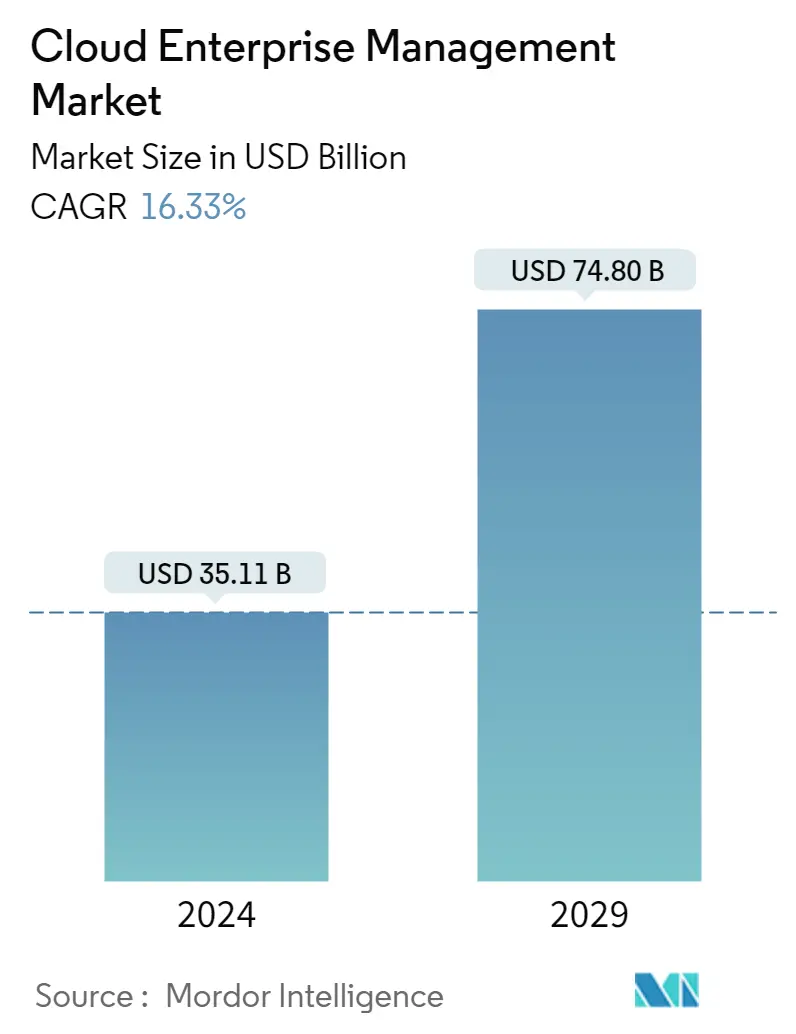Market Size of Cloud Enterprise Management Industry

| Study Period | 2019 - 2029 |
| Market Size (2024) | USD 35.11 Billion |
| Market Size (2029) | USD 74.80 Billion |
| CAGR (2024 - 2029) | 16.33 % |
| Fastest Growing Market | Asia Pacific |
| Largest Market | North America |
Major Players
*Disclaimer: Major Players sorted in no particular order |
Cloud Enterprise Content Management Market Analysis
The Cloud Enterprise Management Market size is estimated at USD 35.11 billion in 2024, and is expected to reach USD 74.80 billion by 2029, growing at a CAGR of 16.33% during the forecast period (2024-2029).
Solutions for enterprise content management (ECM) enable a firm to fully leverage the customer and company knowledge embedded in its content. Business content is captured, stored, activated, analyzed, and automated by ECM solutions, which create new value from previously unstructured and inaccessible data.
- While monitoring performance and costs, cloud management software enables and even automates the movement of workloads between private and public clouds. These technologies have the potential to increase the efficiency of multi-cloud administration significantly.
- The expanding trend of "bring your device" and the increased necessity for agility and flexibility in company operations contribute to the market's expansion (BYOD).
- Unstructured content's rapid expansion significantly hinders many organizations, especially companies. As a result, more businesses are utilizing the advantages of cloud computing.
- Some significant factors driving the migration from legacy ECM solutions to the cloud include the expansion in digital content across companies, the ease of access from remote endpoints, the requirement for regulatory compliance, and the necessity to protect enterprise data from disaster.
- Some of the most significant public cloud obstacles impeding the market's expansion are internet outages and bandwidth limitations, cost control, data privacy and security concerns, resource protection, governance, compliance, and lack of experience.
- The use of video conferencing technologies and virtual conference software dramatically increased due to COVID-19. Governments implemented lockdowns across the globe. The need for internet bandwidth increased dramatically as a result of this. Since it was simple to manage the unexpected surges in bandwidth demand in a corporate cloud scenario, which witnessed market expansion, cloud computing was a lifesaver in such situations.
Cloud Enterprise Content Management Industry Segmentation
Cloud enterprise content management (ECM) combines documents and other content related to any organization's business procedures or workflow on the cloud. Nowadays, enterprises are generating a significantly large amount of data associated with business operations. The need for proper management and regulation of this data has increased substantially. Cloud enterprise content management includes services such as digital asset management, content management, case management, workflow management, and record management across various end users having different deployment models.
The Cloud Enterprise Management Market is segmented by solution (content management, case management, workflow management, record management, and digital asset management), deployment model (public cloud, private cloud, and hybrid cloud), end-user industry (BFSI, medical, and healthcare, manufacturing, and retail), service (professional and managed), organization size (small and medium enterprises, large enterprises), and Geography (North America, Europe, Asia Pacific, Latin America, Middle East & Africa). The market sizes and forecasts are provided in terms of value (USD) for all the above segments.
| By Solution | |
| Content Management | |
| Case Management | |
| Workflow Management | |
| Record Management | |
| Digital Asset Management | |
| Other Solutions |
| By Deployment Model | |
| Public Cloud | |
| Private Cloud | |
| Hybrid Cloud |
| By End-user Industry | |
| BFSI | |
| Energy and Power | |
| Medical and Healthcare | |
| Manufacturing | |
| Retail | |
| IT and Telecom | |
| Other End-user Industries |
| By Service | |
| Professional | |
| Managed |
| By Organization Size | |
| Small and Medium Enterprises | |
| Large Enterprises |
| By Geography | |
| North America | |
| Europe | |
| Asia-Pacific | |
| Latin America | |
| Middle East & Africa |
Cloud Enterprise Management Market Size Summary
The Cloud Enterprise Content Management market is poised for significant growth, driven by the increasing need for businesses to harness the value of unstructured data. ECM solutions enable organizations to capture, store, and analyze business content, transforming it into actionable insights. The shift towards cloud-based solutions is fueled by the expansion of digital content, the necessity for regulatory compliance, and the demand for remote accessibility. The trend of Bring Your Own Device (BYOD) and the need for agility in operations further propel the market. However, challenges such as internet outages, data privacy concerns, and the need for cost control remain obstacles to widespread adoption. The COVID-19 pandemic highlighted the importance of cloud computing in managing unexpected surges in internet bandwidth, further accelerating market growth.
The hybrid cloud sector is expected to dominate the market, offering businesses the flexibility and cost-effectiveness required in today's digital landscape. Hybrid clouds allow organizations to optimize their private cloud's security and flexibility while minimizing expenses, enabling seamless communication between public and private clouds. This approach is particularly beneficial for industries like retail, where advanced data analytics can enhance customer experiences. North America leads the hybrid cloud market, driven by high internet penetration and the adoption of multi-cloud management solutions. The market is consolidated, with major players like Microsoft, IBM, and Oracle dominating, while smaller companies continue to innovate and improve their offerings. Recent technological advancements and strategic collaborations, such as those by Hewlett Packard Enterprise and DocuWare, underscore the ongoing evolution and expansion of cloud enterprise content management solutions.
Cloud Enterprise Management Market Size - Table of Contents
-
1. MARKET INSIGHTS
-
1.1 Market Overview
-
1.2 Industry Value Chain Analysis
-
1.3 Industry Attractiveness - Porter's Five Forces Analysis
-
1.3.1 Bargaining Power of Suppliers
-
1.3.2 Bargaining Power of Buyers/Consumers
-
1.3.3 Threat of New Entrants
-
1.3.4 Threat of Substitute Products
-
1.3.5 Intensity of Competitive Rivalry
-
-
1.4 Technology Snapshot
-
-
2. MARKET SEGMENTATION
-
2.1 By Solution
-
2.1.1 Content Management
-
2.1.2 Case Management
-
2.1.3 Workflow Management
-
2.1.4 Record Management
-
2.1.5 Digital Asset Management
-
2.1.6 Other Solutions
-
-
2.2 By Deployment Model
-
2.2.1 Public Cloud
-
2.2.2 Private Cloud
-
2.2.3 Hybrid Cloud
-
-
2.3 By End-user Industry
-
2.3.1 BFSI
-
2.3.2 Energy and Power
-
2.3.3 Medical and Healthcare
-
2.3.4 Manufacturing
-
2.3.5 Retail
-
2.3.6 IT and Telecom
-
2.3.7 Other End-user Industries
-
-
2.4 By Service
-
2.4.1 Professional
-
2.4.2 Managed
-
-
2.5 By Organization Size
-
2.5.1 Small and Medium Enterprises
-
2.5.2 Large Enterprises
-
-
2.6 By Geography
-
2.6.1 North America
-
2.6.2 Europe
-
2.6.3 Asia-Pacific
-
2.6.4 Latin America
-
2.6.5 Middle East & Africa
-
-
Cloud Enterprise Management Market Size FAQs
How big is the Cloud Enterprise Management Market?
The Cloud Enterprise Management Market size is expected to reach USD 35.11 billion in 2024 and grow at a CAGR of 16.33% to reach USD 74.80 billion by 2029.
What is the current Cloud Enterprise Management Market size?
In 2024, the Cloud Enterprise Management Market size is expected to reach USD 35.11 billion.

